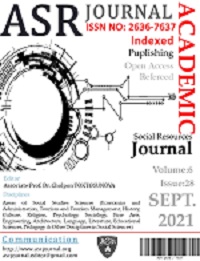Author :
Abstract
Grafik tasarım, görsel iletişim disiplini olarak, toplumları doğrudan etkileyebilme gücüne sahiptir. Toplulukların sosyal ilişkilerinin yanında siyasi, ekonomik, çevre ve eğitimle ilgili etkili mesaj iletme disiplini olduğu bilinmektedir. Mesajın iletimi ve sermaye arasındaki yakın bağlar grafik tasarımcının seçim yapmaya veya taraf olmaya itmektedir. Grafik tasarımcı; bireysel hırsların yanında, kamuya açık retorik bir dil kullanması bakımından üstlendiği etik sorumluluk ile yüzleşmek durumunda kalmaktadır. Aldatma ve ahlaki sınırlar içerisinde hareket eden mesajın iletimine yönelik; reklamveren, yaratıcı ekipler, pazarlama ve grafik tasarımcının tercihi ile ilgili yaklaşımlar incelenirken, grafik tasarım eğitimi ile ilgili disiplinlerarası müdahalelerle oluşan mesleki deformasyona dikkat çekilmektedir. Bireysel çıkarlar ve hırsların zaaflara olanak tanımasının dışında, gerçeğin manipüle edilmesine yönelik oluşturulan hipergerçek dil ve yaşamlar üzerinde durulmaktadır. Grafik tasarımda problemin tespiti ve çözülmesi, mesajın kullanımına dair yaklaşımlar, toplumsal sorumluluk ve ahlaki değerlerin gözardı edilmesi ile birlikte bilinçli kötülük irdelenmektedir. Bununla beraber toplumsal normalar ve etik değerlerin toplumsal devinime etkisi nitel bir metodoloji ile incelenmekte ve grafiğin etiği tartışmaya açılmaktadır.
Keywords
Abstract
Graphic design, as a visual communication discipline, has the power to directly affect societies. In addition to the social relations of the communities, it is known that there is an effective message transmission discipline related to political, economic, environmental and education. The close links between the transmission of the message and the capital push the graphic designer to choose or take sides. Graphic designer; Alongside individual ambitions, it has to confront its ethical responsibility for using publicly rhetorical language. For the transmission of the message that acts within the boundaries of deception and morality; while examining the approaches to the preference of the advertiser, creative teams, marketing and graphic designer, attention is drawn to the professional deformation that occurs with interdisciplinary interventions related to graphic education. Hyperreal language and lives created for the manipulation of reality, individual interests and ambitions that allow for weaknesses are emphasized. In graphic design, the identification and solution of the problem, approaches to the use of the message, ignoring social responsibility and moral values, and conscious evil are examined. In addition, the effect of social norms and ethical values on the social movement is examined with a qualitative methodology and the ethics of the graph is opened to discussion.
Keywords
- Akdur, P. D. R. (2013). Tıbbı Etik ve Meslek Tarihi (Çev.): Songür Eğitim Hizmetleri.
- Akdur, P. D. R. (2013). Tıbbı Etik ve Meslek Tarihi (Çev.): Songür Eğitim Hizmetleri.
- Barlow, J. P. (1996). A Declaration of the Independence of Cyberspace. Erişim Tarihi. 01.06.2021 https://www.eff.org/cyberspace-independence sitesinden alındı
- Boylston, S. (2007). Teaching Toward a Legacy in Graphic Design Education. . Teaching Ethics., 7(2), 49- 62. doi:doi.org/10.5840/tej20077216
- Elrabbaei, I. (2020). The Graphic Label Was Raised as a Visual Means of Communication to the Values and Behavior of the Individual. Art History, 8, 1-11. doi:10.15640/ijaah.v8n1p1
- Emerson, R. M. (1962). Power-Dependence Relations. American Sociological Review, 27(1), 31-41. doi:10.2307/2089716
- Encyclopedia, C. E. (2019). Tim Berners-Lee. In (ss. 1-1): Columbia University Press.
- Frascara, J., Meurer, B., van Toorn, J., & Winkler, D. (1997). User-Centred Graphic Design: Mass Communication And Social Change (Çev.): Taylor & Francis.
- Gino, F. (2015). Understanding ordinary unethical behavior: Why people who value morality act immorally. Current Opinion in Behavioral Sciences, 8. doi:10.1016/j.cobeha.2015.03.001
- Glaser, M. (2004). Ambiguity & Truth. Erişim Tarihi. 08.06.2021 https://www.miltonglaser.com/files/Essays-Ambiguity-8192.pdf sitesinden alındı
- Glover, S. H., Bumpus, M. A., Logan, J. E., & Ciesla, J. R. (1997). Re-examining the Influence of IndividualValues on Ethical Decision Making. In M. Fleckenstein, M. Maury, L. Pincus, & P. Primeaux (Eds.), Fromthe Universities to the Marketplace: The Business Ethics Journey: The Second Annual International Vincentian Conference Promoting Business Ethics (pp. 109-119). Dordrecht: Springer Netherlands.
- Graham, L. M. (2012). Towards a More Sustainable Graphic Design Philosophy. International Journal of the Arts in Society, 6(5), 169-176.
- Graphic, A. G. (2018). Graphic Artists Guild Handbook: Pricing & Ethical Guidelines, 15th Edition (Çev.): Adams Media.
- IFLA. (2021). Internet Manifesto 2014. Erişim Tarihi. 05.07.2021 https://www.ifla.org/publications/internet-manifesto-2014/ sitesinden alındı
- Işır, Ö. (2020). İNTERNET ÇAĞINDA GÖRSEL İLETİŞİM TASARIM ETİĞİ (Çev.).
- LaRossa, B. (2018). Questioning Graphic Design’s Ethicality. Erişim Tarihi. 14.07.2021 https://designobserver.com/feature/questioning-graphic-designs-ethicality/39836/ sitesinden alındı
- Mccarthy, S. (2010). Who’s responsible? Erişim Tarihi. 06.07.2021 http://www.eyemagazine.com/blog/post/whos-responsible sitesinden alındı
- McCollam, P. (2014). Redefining Design Ethics. Design and Culture, 6(3), 315-325. doi:10.2752/175613114X14105155617384
- Monteiro, M. (2017). A Designer’s Code of Ethics. Erişim Tarihi. 16.07.2021 https://deardesignstudent.com/a-designers-code-of-ethics-f4a88aca9e95 sitesinden alındı
- Muhammad ENAD, D. (2018). GRAPHIC DESIGN IS A LANGUAGE THAT PROMOTES CULTURALAND AESTHETIC COMMUNICATION OF SOCIETY %J International Journal of Design and Fashion Studies. 1(2), 20-28. doi:10.21608/ijdfs.2018.180011
- Poon, S. T. F. (2015). Modernisation of Graphic Design: The Possibilities and Challenges of Digitalisation. Journal of Graphic Engineering and Design, 6.
- Roberts, L. (2006). Being good. Erişim Tarihi. 16.07.2021 http://www.eyemagazine.com/opinion/article/being-good sitesinden alındı
- Roberts, L. (2006). GOOD: an Introduction to Ethics in Graphic Design: Ethics of Graphic Design (Çev.): Bloomsbury Academic.
- Romainoor, N. H., Abdullah,Sarena. (2017). EMBRACING CYBERCULTURE ON GRAPHIC DESIGN. Malaysian Journal of Creative Media, Design and Technology, 1(4).
- Sicart, M. (2009). The banality of simulated evil: designing ethical gameplay. Ethics and Information Technology, 11(3), 191-202. doi:10.1007/s10676-009-9199-5
- Steam. (2021). DEFCON. Erişim Tarihi. 16.07.2021 https://store.steampowered.com/app/1520/DEFCON/ sitesinden alındı
- Tenbrunsel, A., & Messick, D. (2004). Ethical Fading: The Role of Self-Deception in Unethical Behavior. Social Justice Research, 17, 223-236. doi:10.1023/B:SORE.0000027411.35832.53
